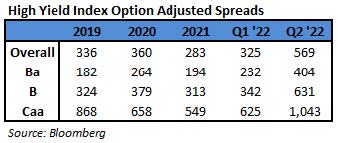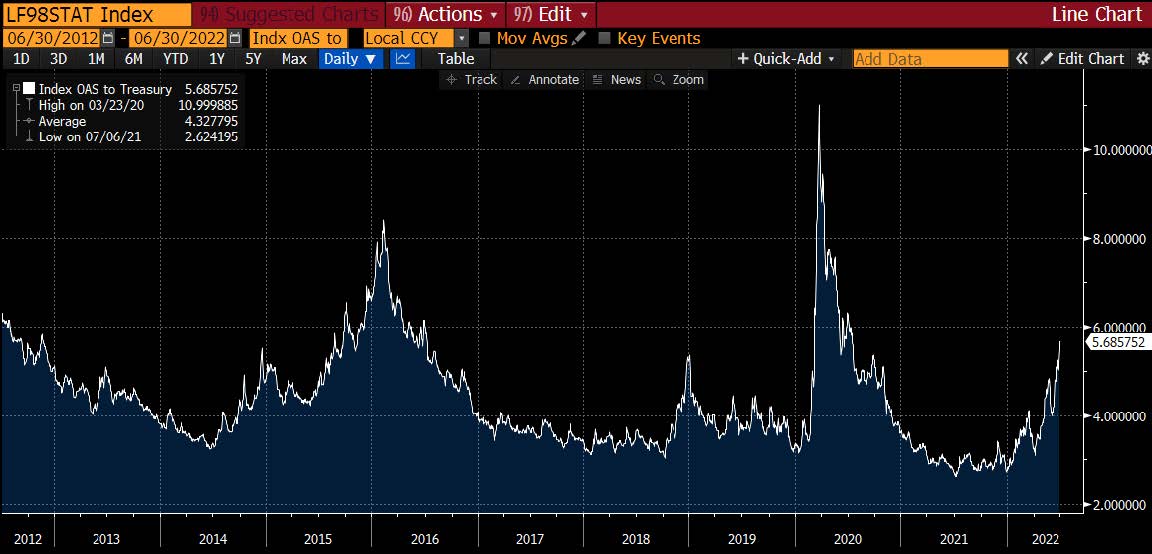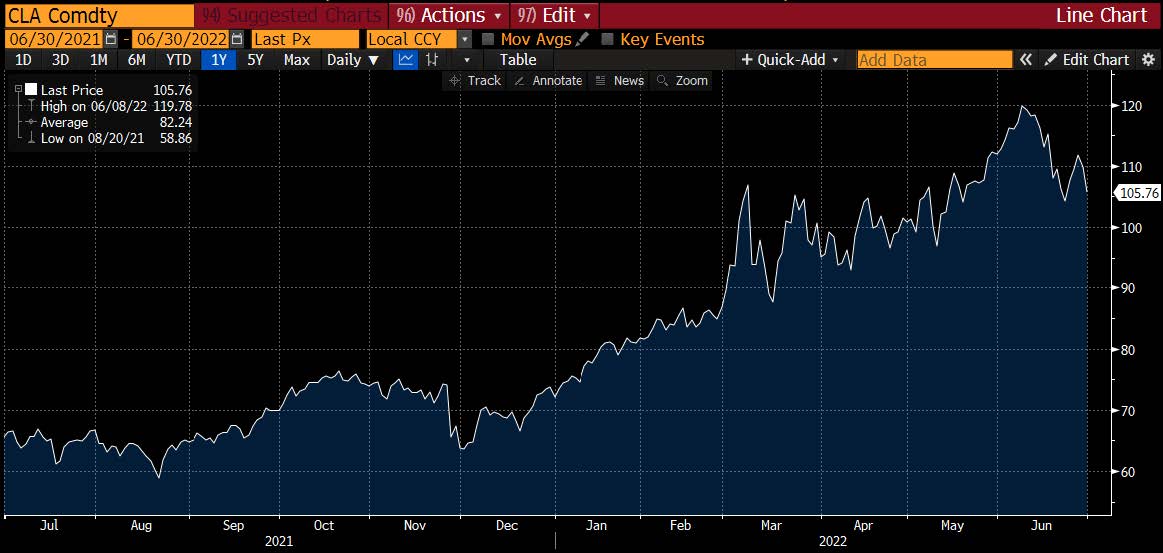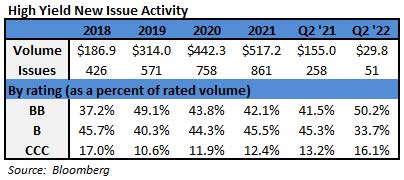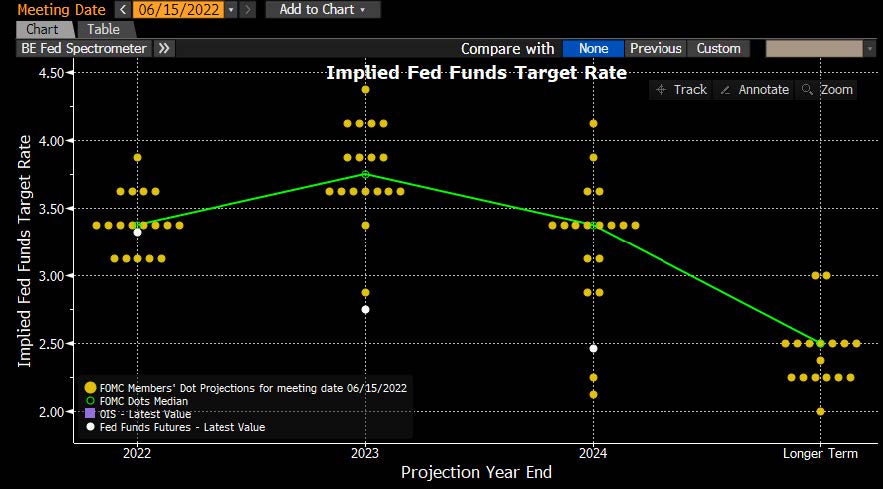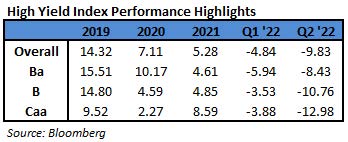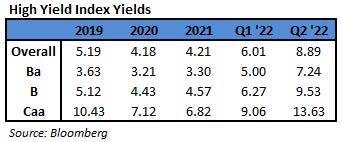Q2 High Yield Quarterly
In the second quarter of 2022, the Bloomberg Barclays US Corporate High Yield Index (“Index”) return was -9.83% bringing the year to date (“YTD”) return to -14.19%. The CAM High Yield Composite net of fees total return was -10.44% bringing the YTD net of fees total return to -15.91%. The S&P 500 stock index return was -16.11% (including dividends reinvested) for Q2, and the YTD return stands at -19.97%. The 10 year US Treasury rate (“10 year”) was generally marching higher as the rate finished at 3.01%, up 0.67% from the beginning of the quarter. Over the period, the Index option adjusted spread (“OAS”) widened 244 basis points moving from 325 basis points to 569 basis points. Each quality segment of the High Yield Market participated in the spread widening as BB rated securities widened 172 basis points, B rated securities widened 289 basis points, and CCC rated securities widened 418 basis points. The chart below from Bloomberg displays the spread moves in the Index over the past ten years with an average level of 433 basis points.
The Utilities, Energy, and Insurance sectors were the best performers during the quarter, posting returns of -6.98%, -8.02%, and -8.17%, respectively. On the other hand, Brokerage, Finance, and Consumer Non-Cyclical were the worst performing sectors, posting returns of -12.64%, -11.38%, and -11.33%, respectively. Clearly the market was weak as all sectors posted a negative return in the period. At the industry level, refining, food and beverage, and paper all posted the best returns. The refining industry posted the highest return -2.79%. The lowest performing industries during the quarter were pharma, retailers, and building materials. The pharma industry posted the lowest return -19.33%.
The energy sector continues to be a topic within the inflation discussion. Crude oil has continued higher reaching a high of $120 a barrel in early June. OPEC+ members recently bumped up production which was the last bit to restore all that was shuttered due to the pandemic.i President Biden has a scheduled trip to Saudi Arabia later this month. However, asking the Saudis to pump more oil is not on the agenda, as the President indicated that the Gulf Cooperation Council meeting is the more appropriate place for that request.
Given the rising spreads, rising yields, and volatility, the primary market remained very subdued during the second quarter. The weak market led to year-to-date issuance of $75.6 billion and $29.8 billion in the quarter. Energy took 24% of the market share followed by Discretionary at a 19% share. Wall Street strategists continue to lower their full year issuance forecasts. However, there isn’t much concern for lack of capital access due to issuers being so proactive with refinancing in the past few years. In fact, only about $70 billion in high yield bonds are due to mature from now through the end of 2023.
The Federal Reserve lifted the Target Rate by 0.50% at their May meeting and by an additional 0.75% at their June meeting. The chart to the left shows the updated Fed dot plot post the June meeting. Of note, the Fed median Target Rate for 2022 increased from 1.875 to 3.375. Such movement is a clear indication of the dynamic economic backdrop. After the June meeting, Fed Chair Jerome Powell acknowledged that the 0.75% hike was “an unusually large one.” It was the largest hike since 1994. As he later spoke in front of the Senate Banking Committee, he called the possibility of a soft landing “very challenging.”ii He went on to say, “The other risk, though, is that we would not manage to restore price stability and that we would allow this high inflation to get entrenched in the economy. We can’t fail on that task. We have to get back to 2% inflation.” Inflation is running higher than any point in the last 40 years and the Fed, having updated their Summary of Economic Projections, accepts that the continuing rate hikes are going to lower growth and push up unemployment.
Intermediate Treasuries increased 67 basis points over the quarter, as the 10-year Treasury yield was at 2.34% on March 31st, and 3.01% at the end of the second quarter. The 5-year Treasury increased 58 basis points over the quarter, moving from 2.46% on March 31st, to 3.04% at the end of the second quarter. Intermediate term yields more often reflect GDP and expectations for future economic growth and inflation rather than actions taken by the FOMC to adjust the Target Rate. The revised first quarter GDP print was -1.6% (quarter over quarter annualized rate). Looking forward, the current consensus view of economists suggests a GDP for 2022 around 2.5% with inflation expectations around 7.5%.iii The will we or won’t we recession camps are still divided. The former Vice Chair of the FOMC Bill Dudley said a recession is inevitable within the next 12 to 18 months. The Chief Economist at JP Morgan said “there’s no real reason to be worried about a recession.” Meanwhile, strategists at Citi wrote in a report that the market is pricing in a 50% probability.
Being a more conservative asset manager, Cincinnati Asset Management Inc. does not buy CCC and lower rated securities. This policy generally served our clients well in 2020. While this segment did outperform last year, after 15 months CCC’s are again underperforming as we expect in times of market stress. Our interest rate agnostic philosophy keeps us generally positioned in the five to ten year maturity timeframe. Due to the continued rate moves, this positioning was a detractor as the sub-three year maturity cohort provided the best performance in the quarter. As a result and noted above, our High Yield Composite net of fees total return did underperform the Index in Q2. Additionally, our credit selections within cable/satellite and leisure were a drag on performance. Benefiting our performance was our lack of exposure to pharma and our credit selections within consumer services, midstream, and retail.
The Bloomberg Barclays US Corporate High Yield Index ended the second quarter with a yield of 8.89%. The market yield is an average that is barbelled by the CCC rated cohort yielding 13.63% and a BB rated slice yielding 7.24%. Equity volatility, as measured by the Chicago Board Options Exchange Volatility Index (“VIX”), had an average of 27 over the quarter moving as high as 35 in the beginning of May. For context, the average was 15 over the course of 2019, 29 for 2020, and 19 for 2021. The second quarter had four bond issuers default on their debt. The trailing twelve month default rate stands at 0.86%.iv The current default rate is relative to the 1.63%, 0.92%, 0.27%, 0.23% default rates from the previous four quarter end data points listed oldest to most recent. The fundamentals of high yield companies still look good considering the economic backdrop. From a technical view, fund flows were negative in all three months of the quarter. The 2022 year-to-date outflow stands at $46.0 billion.v Without question there has been a fair amount of damage in bond markets so far this year. It is important to remember that bonds are a contractual agreement with a defined maturity date. Thus, despite any price volatility, without default, par will be paid at the stated maturity date. Currently, defaults are quite low and fundamentals are quite high. No doubt there are risks, but we are of the belief that for clients that have an investment horizon over a complete market cycle, high yield deserves to be considered as part of the portfolio allocation.
The backdrop as we move into the second half of 2022 is quite interesting. The University of Michigan Consumer Sentiment reading is the worst ever, the S&P 500 recorded the worst first half in over fifty years, inflation is at levels not seen in over forty years, the Fed hiked a rate at one meeting not seen in almost thirty years, and naturally the bond markets are under heavy pressure. Implied inflation, using breakeven inflation rates, is well off recent highs. Further, corn and wheat have fallen about 20% from recent highs. Given all of this, the high yield market is yielding almost 9% with a spread north of 550 basis points. Clearly, it is important that we exercise discipline and selectivity in our credit choices moving forward. We are very much on the lookout for any pitfalls as well as opportunities for our clients. We will continue to carefully monitor the market to evaluate that the given compensation for the perceived level of risk remains appropriate on a security by security basis. As always, we will continue our search for value and adjust positions as we uncover compelling situations. Finally, we are very grateful for the trust placed in our team to manage your capital.
This information is intended solely to report on investment strategies identified by Cincinnati Asset Management. Opinions and estimates offered constitute our judgment and are subject to change without notice, as are statements of financial market trends, which are based on current market conditions. This material is not intended as an offer or solicitation to buy, hold or sell any financial instrument. Fixed income securities may be sensitive to prevailing interest rates. When rates rise the value generally declines. Past performance is not a guarantee of future results. Gross of advisory fee performance does not reflect the deduction of investment advisory fees. Our advisory fees are disclosed in Form ADV Part 2A. Accounts managed through brokerage firm programs usually will include additional fees. Returns are calculated monthly in U.S. dollars and include reinvestment of dividends and interest. The index is unmanaged and does not take into account fees, expenses, and transaction costs. It is shown for comparative purposes and is based on information generally available to the public from sources believed to be reliable. No representation is made to its accuracy or completeness.
The information provided in this report should not be considered a recommendation to purchase or sell any particular security. There is no assurance that any securities discussed herein will remain in an account’s portfolio at the time you receive this report or that securities sold have not been repurchased. The securities discussed do not represent an account’s entire portfolio and in the aggregate may represent only a small percentage of an account’s portfolio holdings. It should not be assumed that any of the securities transactions or holdings discussed were or will prove to be profitable, or that the investment decisions we make in the future will be profitable or will equal the investment performance of the securities discussed herein.
i Bloomberg June 30, 2022: OPEC+ Ratifies August Supply Hike
ii Bloomberg June 22, 2022: Powell Says Soft Landing ‘Very Challenging’
iii Bloomberg July 1, 2022: Economic Forecasts (ECFC)
iv JP Morgan July 1,, 2022: “Default Monitor”
v Wells Fargo June 30, 2022: “Credit Flows”
